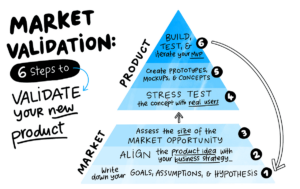Starting a business is a thrilling adventure filled with endless possibilities, but it can also be overwhelming without the right guidance. Having a comprehensive checklist can transform your vision into reality. This business checklist serves as your roadmap, taking you step by step through the essential processes of launching your venture. From crafting a solid business plan and understanding your target market to navigating legal requirements and developing effective marketing strategies
1.Market research and business idea validation

Market research and business idea validation are crucial steps in the journey of starting a successful business. Before diving headfirst into your entrepreneurial venture, taking the time to thoroughly understand your target market is essential. Begin by identifying your ideal customer profile who they are, what their needs are, and how your product or service can address those needs. Utilize surveys, interviews, and focus groups to gather qualitative and quantitative data that can inform your decisions.
Once you have a clear grasp of your target audience, it’s vital to analyze the competitive landscape. Investigate existing businesses that offer similar products or services. What are their strengths and weaknesses? How do they market themselves, and what can you do differently to stand out? This not only helps you identify potential gaps in the market but also sheds light on effective strategies that you can adopt or adapt.
After conducting comprehensive market research, it’s time to validate your business idea. This involves testing your concept through minimum viable products (MVPs) or prototypes. Release a simplified version of your offering to a select group of potential customers, you can gather valuable feedback without committing significant resources. Pay close attention to their reactions and suggestions this information is invaluable and can help refine your product to better meet market demand. Incorporating insights from your research and validation process will prepare you to move forward confidently, ensuring that your business is not only viable but poised for success.
2. Create a solid business plan

Creating a solid business plan is one of the most crucial steps in your entrepreneurial journey, serving as the blueprint for your business’s success. A well-crafted business plan not only clarifies your vision and objectives but also provides a roadmap that guides your decisions and strategies as you navigate the complexities of starting and growing your business.
Begin by outlining your business concept, detailing what products or services you will offer and what makes your business unique in the marketplace. This is your opportunity to articulate your mission statement and the core values that will drive your operations. As you develop your business plan, include a comprehensive marketing strategy that outlines how you intend to reach and attract customers. This should encompass your branding approach, promotional tactics, and sales channels. Additionally, it’s vital to address the financial components of your plan. Create detailed financial projections, including startup costs, revenue forecasts, and a break-even analysis. This not only helps you understand the financial viability of your business but also is essential for securing funding from investors or lenders.
Finally, ensure that your business plan is adaptable. The entrepreneurial landscape is ever-changing, and being open to refining your plan in response to new insights or market shifts will position your business for long-term success. Remember, a solid business plan is not merely a document; it’s a living guide that will evolve as your business grows and changes.
3. Choose a business structure

Choosing the right business structure is a crucial step in your entrepreneurial journey, as it lays the foundation for your operations, liabilities, and tax obligations. In essence, your choice will not only impact how you manage your business but will also influence your personal financial safety and the overall growth potential of your venture.
Start by evaluating the common business structures available: sole proprietorship, partnership, limited liability company (LLC), and corporation. Each comes with its own set of advantages and disadvantages, tailored to different types of businesses and personal goals.
A sole proprietorship is the simplest and most common structure, perfect for solo entrepreneurs. It allows you full control over your business, but it also means you are personally liable for any debts or legal actions. Conversely, if you’re considering collaboration, a partnership might be suitable, allowing you to share responsibilities and resources with one or more individuals, though it also requires clear agreements to mitigate risks.
For those who wish to protect their personal assets while enjoying the flexibility of a more complex structure, a limited liability company (LLC) is an attractive option. This structure combines the benefits of a corporation and a partnership, providing protection against personal liability while allowing for pass-through taxation. This means profits are taxed only at the individual level, avoiding the double taxation that often burdens corporations.
If you’re aiming for significant growth and plan to raise capital through investors, consider forming a corporation. This structure offers robust protection against personal liability and allows for greater flexibility in ownership through stock issuance. However, it comes with more regulatory requirements and can be more complex to manage.
As you ponder your options, consider factors such as the level of acceptable risk, management style, tax implications, and long-term business goals. Consulting with legal and financial professionals can provide clarity and guidance tailored to your specific situation. Taking the time to thoughtfully choose the right business structure will not only set the tone for your operational efficiency but also safeguard your personal assets, ensuring a smoother path to success as you embark on this exciting entrepreneurial adventure.
4. Understanding legal requirements
This aspect of your business plan lays the groundwork for your venture’s legitimacy and long-term success. Once you have determined the legal structure of your business, select a memorable and unique business name that reflects your brand identity. Next, make sure to register your business name. This process may vary depending on your location, but generally involves checking name availability and filing for trademarks if necessary. Securing the right permits and licenses is another vital component. Depending on your industry, location, and the nature of your business, you may require specific local, state, or federal licenses. Research the necessary requirements thorough, as operating without the proper permits can lead to hefty fines or even closure.
Additionally, it’s important to consider compliance with tax obligations. This includes applying for an Employer Identification Number (EIN) through the IRS if you plan on hiring employees or operating as a corporation or partnership. Understanding your tax responsibilities and maintaining accurate financial records from the start will streamline your operations and help you avoid legal complications down the line.
Lastly, don’t underestimate the value of consulting with a legal professional or business advisor. They can provide tailored guidance specific to your unique situation, helping you navigate the complexities of business law and ensuring that you are fully compliant with all necessary regulations.
5. Securing funding and financial planning

Securing funding and establishing a robust financial plan are crucial steps in transforming your entrepreneurial dreams into a thriving reality. Once you have a clear business idea and a solid business plan, it’s time to delve into the financial aspects that will help sustain your venture. Start by evaluating your funding options—you might consider personal savings, loans from family and friends, or traditional bank loans. Additionally, exploring alternative routes such as crowdfunding platforms, angel investors, or even venture capital can provide the financial boost you need.
When seeking funding, it’s essential to present a compelling case to potential investors or lenders. This involves detailing not only your business concept but also demonstrating how you plan to generate revenue and manage expenses. Prepare comprehensive financial projections that include startup costs, operating expenses, and anticipated revenue streams over the first few years. This not only showcases your professionalism but also reassures stakeholders of your commitment to success.
Once you secure funding, effective financial planning is paramount. Establish a budget that clearly outlines your expected income and expenditures, allowing you to track your financial health regularly. Utilizing accounting software can streamline this process, making it easier to manage cash flow and monitor financial performance. Regularly reviewing your financial plan and adjusting as necessary is vital to staying on course.
6. Build your brand

Building your brand is a crucial step in launching a successful business, as it defines how you want your customers to perceive your company. This is where you create a unique identity that sets you apart from the competition. The brand should resonates with your target audience and encapsulates the essence of your business. Consider the emotions you want to evoke and the message you wish to convey.
Next, design a captivating logo that visually represents your brand. This symbol will become the face of your business, so it should be memorable and versatile enough to be used across various platforms, from your website to your social media pages. Choose a color palette that reflects your brand’s personality—warm colors can evoke feelings of comfort, while cooler tones might convey professionalism.
Once you have the visual elements in place, it’s time to craft your brand voice. This includes the tone and style of your communication, whether it’s casual and friendly or formal and authoritative. Consistency is key; your brand’s voice should be reflected in all your marketing materials, customer interactions, and content.
Additionally, consider your online presence. A professional website is essential—it should not only showcase your products or services but also tell your brand story and provide a seamless user experience. Engage with your audience through social media platforms that align with your target demographic, and remember that storytelling can be a powerful tool in building brand loyalty. Lastly, monitor and adapt your brand strategy over time. Collect feedback from customers, analyze your market, and be willing to make adjustments as necessary. Building a strong brand is not a one-time effort; it requires ongoing commitment and creativity.
7. Set up your finances
Setting up your finances is a crucial step in starting a business, as it lays the foundation for your financial health and success. Begin by opening a dedicated business bank account. This will help you keep your personal and business finances separate, making it easier to track income and expenses for tax purposes. Choose a bank that offers the services you need, such as low fees, online banking, and a user-friendly interface.
Next, consider working with an accountant or financial advisor, especially if you’re new to managing business finances. They can provide valuable insights into tax strategies, budgeting, and cash flow management, helping you navigate the complexities of business finance with confidence. It’s also wise to establish a bookkeeping system, whether through software like QuickBooks or by hiring a bookkeeper. Keeping accurate records of all transactions will not only simplify tax season but also provide you with a clear view of your financial health.
Additionally, create a budget that outlines your projected income and expenses. This will serve as a roadmap for your business and help you make informed decisions. Don’t forget to factor in unexpected costs; having a financial cushion can be a lifesaver in case of emergencies.
8. Hire employees (if needed)
Hiring employees is a pivotal step in your entrepreneurial journey, particularly if you find yourself overwhelmed with tasks or lacking specific skills essential for your business’s success. As you move closer to launching your venture, consider the roles that will best support your goals and the skill sets that will complement your own. Begin by outlining the key positions you need to fill, whether it’s a marketing specialist, a customer service representative, or a financial advisor.
When crafting job descriptions, be clear and concise about the responsibilities and qualifications required for each role. This will not only attract the right candidates but also streamline the hiring process. Utilize various platforms to post your job listings—job boards, social media, and local networking groups can all be valuable resources for finding talent.
Once applications start rolling in, develop a structured interview process to evaluate candidates effectively. During interviews, assess not just their qualifications but also their cultural fit within your business. Look for individuals who exhibit enthusiasm, adaptability, and a strong work ethic; these qualities can be just as important as technical skills.
After selecting your candidates, ensure you have a proper onboarding process in place. This will help new hires acclimate to your business culture and understand their roles clearly. Remember, investing time in selecting the right employees can lead to a more productive, motivated team that contributes significantly to your business’s overall success. With the right people by your side, you’ll be well on your way to turning your vision into reality.
9. Launch your business

Launching your business is a thrilling moment, often the culmination of months or even years of planning, dreaming, and hard work. As you approach this pivotal stage, it’s essential to ensure that all elements are in place for a successful launch. Start by finalizing your business name and registering it, securing any necessary permits and licenses to operate legally. With the legalities covered, turn your attention to your branding; design a striking logo and develop a cohesive brand identity that resonates with your target audience.
Next, create a professional online presence. This means launching a user-friendly website that showcases your products or services, complete with engaging content that reflects your brand’s voice. Don’t underestimate the power of social media; establish profiles on relevant platforms to connect with potential customers and build a community around your brand.
As the launch date approaches, it’s time to develop a marketing strategy to generate buzz. Consider hosting a launch event either virtual or in-person to introduce your business to the world. Offer promotions or giveaways to entice early customers and encourage them to spread the word.
Finally, take a moment to reflect on your goals and strategies. Set measurable objectives for your first few months and prepare to adapt as you learn from your audience’s feedback. Remember, launching your business is just the beginning of your journey. Stay committed, stay flexible, and embrace the challenges ahead with confidence.
10. Continuously learn and adapt
In the fast-paced world of entrepreneurship, the journey doesn’t end once you launch your business; in fact, it’s just the beginning. Continuously learning and adapting is essential to not only survive but thrive in your industry. The business landscape is constantly evolving, influenced by market trends, consumer preferences, and technological advancements. To stay ahead of the curve, you must cultivate a mindset of lifelong learning. This could involve attending workshops, enrolling in online courses, or simply following industry leaders and reading up on the latest research and reports.
Moreover, feedback is a key component of this process. Regularly seek input from customers, employees, and mentors. Their insights can provide invaluable perspectives on what’s working and what needs improvement. Utilizing this information allows you to pivot your strategies and offerings to better meet the needs of your target audience. Additionally, embrace the power of networking. Surround yourself with fellow entrepreneurs and industry experts who can share their experiences and advice. Participating in forums, conferences, or local business groups can expose you to new ideas and practices that could enhance your operations. Finally, don’t shy away from experimentation. Test new approaches, whether with your marketing strategies, product lines, or customer service methods. Evaluate the results and be willing to make changes based on what you learn.
Conclusion
Starting a business is an exhilarating journey filled with opportunities and challenges, and having a comprehensive checklist can be your roadmap to success. As we’ve explored throughout this guide, from conducting market research and crafting a solid business plan to understanding your financial requirements and navigating legal obligations, each step is essential in laying a strong foundation for your entrepreneurial dreams.
As you stand ready to embark on this exciting venture, remember that flexibility and adaptability are key. The business landscape is ever-evolving, and being open to change can often lead to new opportunities. Surround yourself with a network of support, whether through mentors, fellow entrepreneurs, or industry professionals, as their insights can be invaluable.
Don’t forget to celebrate your milestones, no matter how small. Each achievement brings you closer to your ultimate vision and reinforces the hard work you’ve put into turning your ideas into reality. With the right preparation and mindset, you’re not just starting a business; you’re paving the way for a brighter future.
